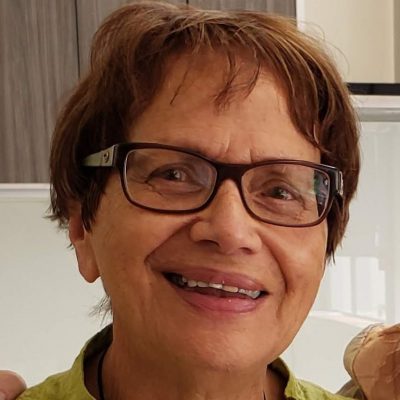
Peti, one of our longest-serving museum volunteers
We slept remarkably well during our last night in Hamilton. We spent the morning finishing our packing and then went back to the Matthew Cowley Pacific Church History Centre to turn in our keys and say goodbye for absolutely the last time. Before we left the flat, Nancy received a text from Peti, one of our longest-serving and most dependable museum volunteers, asking if we would be at the Mendenhall Building at all that day. She hoped she hadn’t missed her opportunity to give us a parting gift, and we were glad that we hadn’t missed our opportunity to exchange a parting hug with her. Peti had taught English for many years at the Church College of New Zealand and later, after the college closed, she volunteered to help preserve the school’s material legacy, organizing documents and memorabilia from its fifty years of operation. If not for people like Peti, much of what’s on display in the MCPCHC’s CCNZ exhibit might have ended up in a “tip” (the local term for “dumpster”) and we are grateful for their foresight. In addition to working as a uniquely knowledgeable museum docent, Peti also served as an excellent editorial resource while Nancy was preparing text for the Sacrifice and Consecration exhibit, ensuring that nothing sounded too much like an American had written it. We were relieved to discover that there was no chocolate in the package of farewell gifts Peti handed us, but rather some beautiful Christmas ornaments and a couple of metres of fabric printed with a bold Māori design. “I heard you were planning to make a quilt,” she explained. That’s Peti: always thoughtful, always practical.
As Nancy bestowed her key to the MCPCHC on Sheryl B, the part-time volunteer who would be assisting Jo-Ena with museum operations, she was thankful to have had a few weeks to become acquainted with Sheryl. Sister B has demonstrated that she not only has enough knowledge of local Church history to be an effective museum guide (once the museum reopens) but also the practical skills that will make her a real asset to the whole Church History Department. Although we’re concerned that it’s likely to be many months before any more full-time Church History missionaries are assigned to take our places (and Diane’s) at the MCPCHC, we have no doubt that the Centre will continue to function successfully because Sheryl, Ken, and Marilyn have proven to be such capable and committed workers.
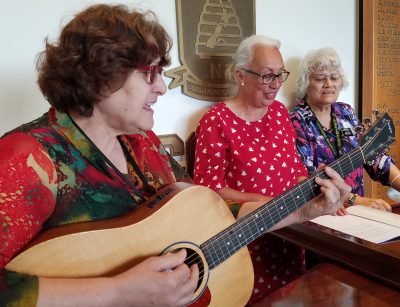
Sheryl, Helena and Viginia sing one of several waiata
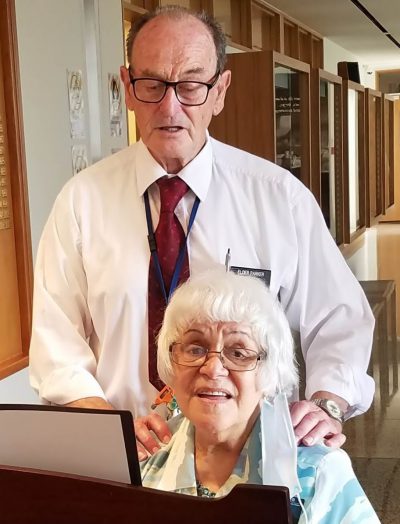
Vic and Rangi sing their farewell song
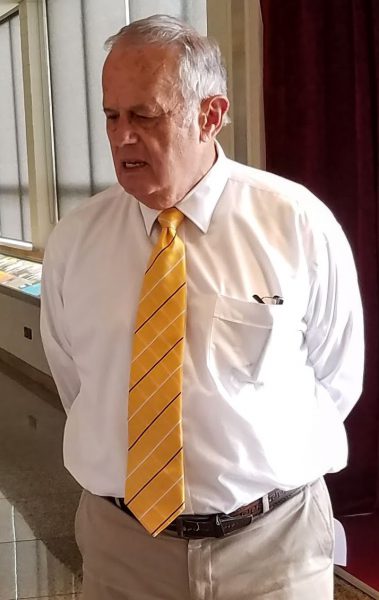
Ken delivers the kōrero
Having set foot in the Mendenhall Building one last time, we couldn’t get away until Elder E had gathered the whole MCPCHC staff around the piano for a traditional mihi whakamatunga (farewell ceremony) that included a te reo kōrero (a speech in Māori) from Ken and the singing of several waiata. It was a loving and gracious send-off and we were sincerely appreciative, but by this time, we were emotionally ready to just get on our way. The time had come to let go and let God take care of the MCPCHC.
New Zealand’s patchwork of geographical COVID restrictions had kept us out of Auckland and away from our friends there for more than three months. However, because the only way we could leave the country was to fly out of Auckland International Airport, our tickets for Air New Zealand Flight 6 to Los Angeles now became our tickets to travel beyond the Waikato-Auckland security checkpoint. Based on the idea that we needed time to return the vehicle we had been using to “our sponsoring organization” (the Church’s Pacific Area office in Auckland) we had applied for an exemption to the rule stipulating that international travelers could cross the boundary only within 24 hours of their scheduled flight, and we had learned just the day before that our request had been granted. That morning we also had received confirmation that our COVID tests were negative. So now we were in the car, leaving Temple View for the last time, eager to get on Route 1 so we could get to Auckland before rush hour and meet Jeff, Kara, Barry, and Eva. But just as we approached the Dinsdale roundabout, Michael was suddenly overcome by panic. What had he done with his jacket and hat? He couldn’t remember putting them in the car, so he pulled to the side of the road to check inside the boot. He didn’t see them. “I must have left them at home on the couch,” he said grimly.
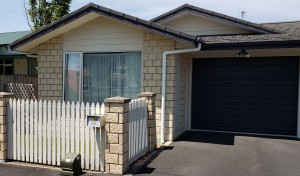
5A Lyon Street: our home for nearly two years
We had already turned the key to 5A Lyon Street over to Elder A, so we had to drive back to the Mendenhall Building and hope that we wouldn’t trigger another round of anticlimactic farewells should anyone from the MCPCHC see Michael sneak upstairs to the mission office. He managed to find Elder A and retrieve the key without attracting anyone else’s attention, but when we got back to the flat, Michael’s jacket and hat were not on the couch—nor anywhere else inside. Eventually, he found them tucked in a corner of the boot that he was sure he had checked before, but the whole incident was indicative of the wildly distracted state of Michael’s mind.
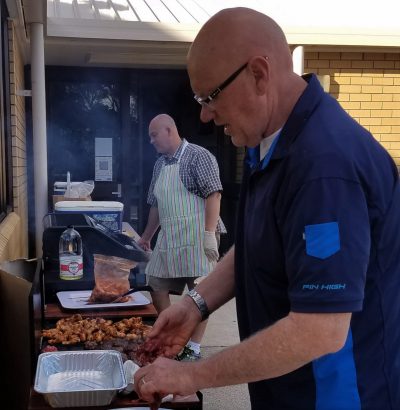
Grant at the barbie during a Dinsdale Ward activity
Our unplanned return to the flat in Frankton was not a complete waste of time, however, because as we passed Campbell Street on our way to Lyon Street, Michael had a moment of clarity and remembered that he had not made good on a promise to visit Grant before we left. We had already bid farewell to Grant’s wife, Barbara, and their son Reed at the Dinsdale Ward picnic, but Grant had been sick that night and unable to attend, and it had been a few weeks since we had seen him. Grant has been one of our truest Kiwi friends, so we made a brief stop at his home/office, hoping we could avoid interrupting him at work on a patient. As an acupuncturist, Grant has more than once offered Michael relief from occasional back pain. As the ward music chairman, Grant has avidly supported the choir, not only singing but also providing copies of all the sheet music Michael asked for. As a terrific cook, Grant has prepared some memorable meals for us, both at his home and at ward activities. Having lived in China for several years, he specializes in authentic Asian cuisine, and he’s an expert at the barbie. We would have felt awful had we left New Zealand without saying goodbye to Grant, so we were glad that he was available when we stopped in Campbell Street.

Kara and Jeff welcome us to Auckland
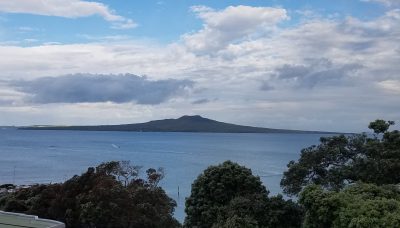
View of Rangitoto from Barry and Eva’s balcony
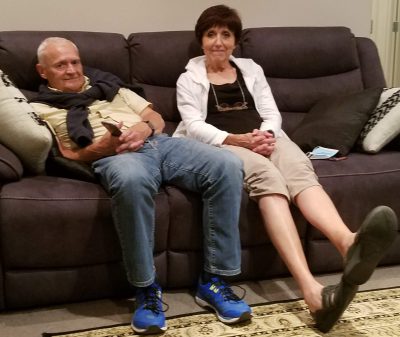
Barry and Eva relaxing at Shoalhaven
Despite the fact that it was after 3 p.m. when we got on Route 1, we made it to Auckland and over the harbour bridge by 5:00, before traffic got too bad. The officer who had stopped us at the COVID security checkpoint near Pokeno was not the surly functionary one might have expected, but rather a pleasant, friendly woman who waved us through with a smile as soon as she had ascertained that we had all the necessary certifications. When we reached Shoalhaven, the high-rise apartment building where many of the senior missionaries who work in the Church’s Pacific Area office live, Kara and Jeff were quick to greet us with open arms and hugs. It was so good to see them! And within half an hour, we were able to meet Eva and Barry as well. The six of us gathered outside a kebab place in Takapuna to order takeaway plates because, due to COVID restrictions, none of Auckland’s restaurants offered dining-in. We carried our food to Barry and Eva’s nearby flat, where we sat on the balcony and enjoyed the spectacular view of Takapuna Beach and Rangitoto Island.
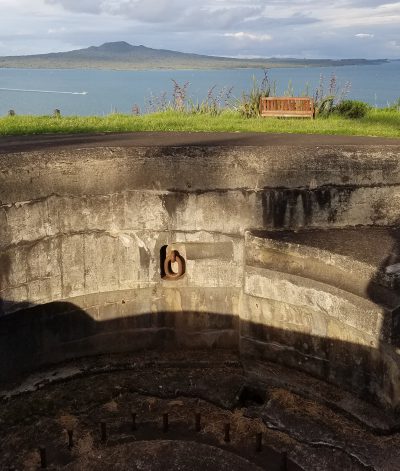
Remains of Auckland’s coastal defense on North Head
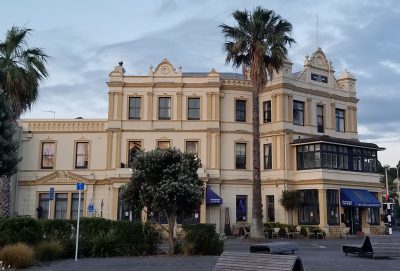
Esplanade Hotel in Devonport
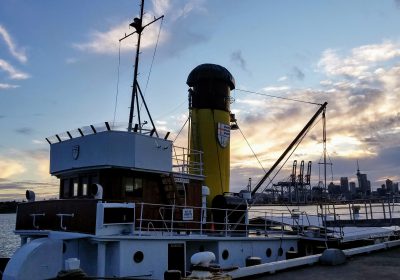
The William C Daldy, named for the first chairman of Auckland’s Harbour Board, moored at Victoria Wharf. It is the largest operating steam ship in the country

“Flight Trainer for Albatross,” 2004, by local sculptor Greer Twiss, was a controversial addition to Victoria Wharf. We think we know why
When we had finished eating, we all drove up to the Maungauika/North Head Historic Reserve in Devonport, located at the south end of the peninsula that helps protect Waitematā Harbour. In the mid-nineteenth century, North Head became the site of Auckland’s first pilot station; later, when an armed conflict between the Russian and British Empires struck fear of invasion into the hearts of New Zealanders, it became the site of a strategic military installation. The attack never materialized, but the Kiwis were prepared with defenses that included three batteries of big guns and a warren of tunnels and underground arsenals. The fort was expanded as the command center of Auckland’s coastal defense during World War II, and for many years after that it served as a Navy training school. By the end of the twentieth century, however, with its weaponry outmoded and its fortifications crumbling, North Head was transferred from the military to the Department of Conservation, which turned the picturesque promontory into a historical reserve. We found it rather peaceful to walk among the abandoned armaments and explore the tunnels, and we especially enjoyed the headland’s panoramic vistas.
We descended the hill from the lookout just before the sun began its own descent over Auckland. From Devonport’s Victoria Wharf, we had a stunning view of the city center across Waitematā Harbour as the sky in the background darkened dramatically. Our evening ended back at Shoalhaven, where a chocolate cream pie that Kara had made earlier awaited us. Because the flat next door to Kara and Jeff’s had recently been vacated by another senior missionary couple returning to the U.S., we were able to spend the night there. We reluctantly excused ourselves from the conversation with our four dear friends and turned in early, knowing that we probably wouldn’t get much sleep over the next couple of days.
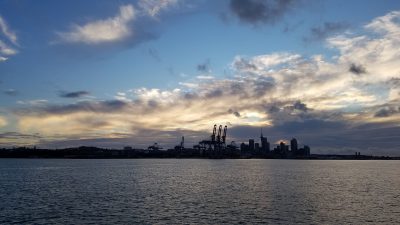
View across Waitematā Harbour from Devonport

Welcome to Ōrewa Beach
Wednesday 1 December, our last day in New Zealand, began with an early morning stroll on the beach at Ōrewa. Jeff had arranged to borrow the mission van for the day so our sextet could travel together—and also so we would have a vehicle large enough to transport us and all our luggage to the airport when the time came.
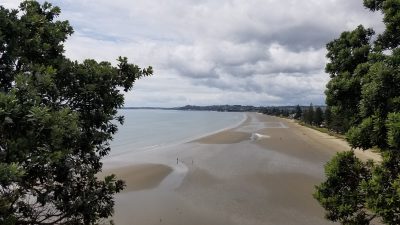
Ōrewa Beach
Located north of Auckland on the Pacific shore, Ōrewa turned out to be a great place to collect seashells, especially conical whelks.
“More shells?” Michael asked with dismay as Nancy filled another plastic bag. “Don’t we have enough already?”
“But these are different,” Nancy insisted. “We don’t have any others like these. And they’re so nice! None of them are broken!”
Eva and Kara were collecting them, too. Later, the three women would do their best to rinse out the sand and use bleach to destroy whatever was still living inside. Nancy saved a dozen of her best specimens and was happy that they fit snugly—and safely, she hoped—into the packages she’d already created for her collection of fragile shells.
Nancy’s New Zealand Sea Shell Collection
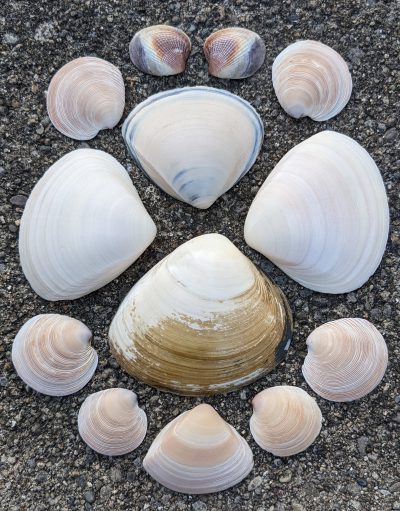 |
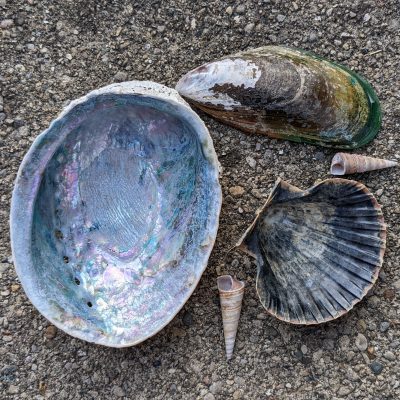 |
 |
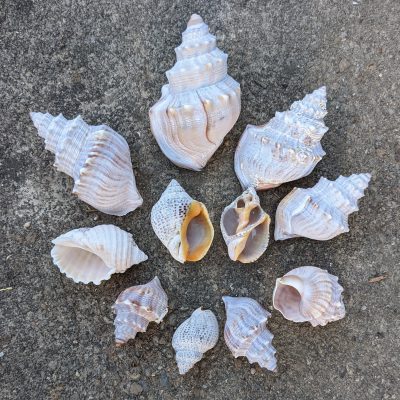 |
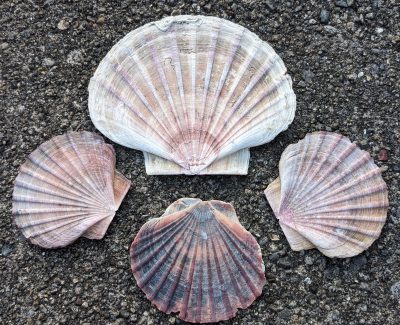 |
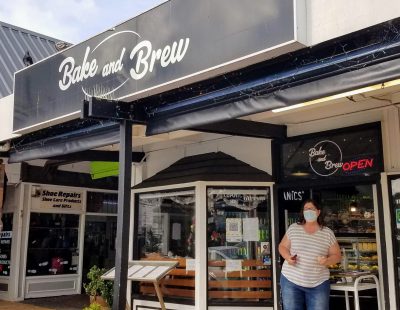
Take-away breakfast from the Bake and Brew
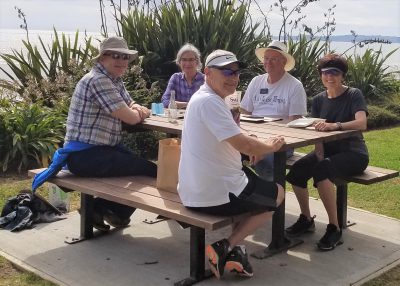
Eating breakfast in the Moana Reserve at Ōrewa Beach
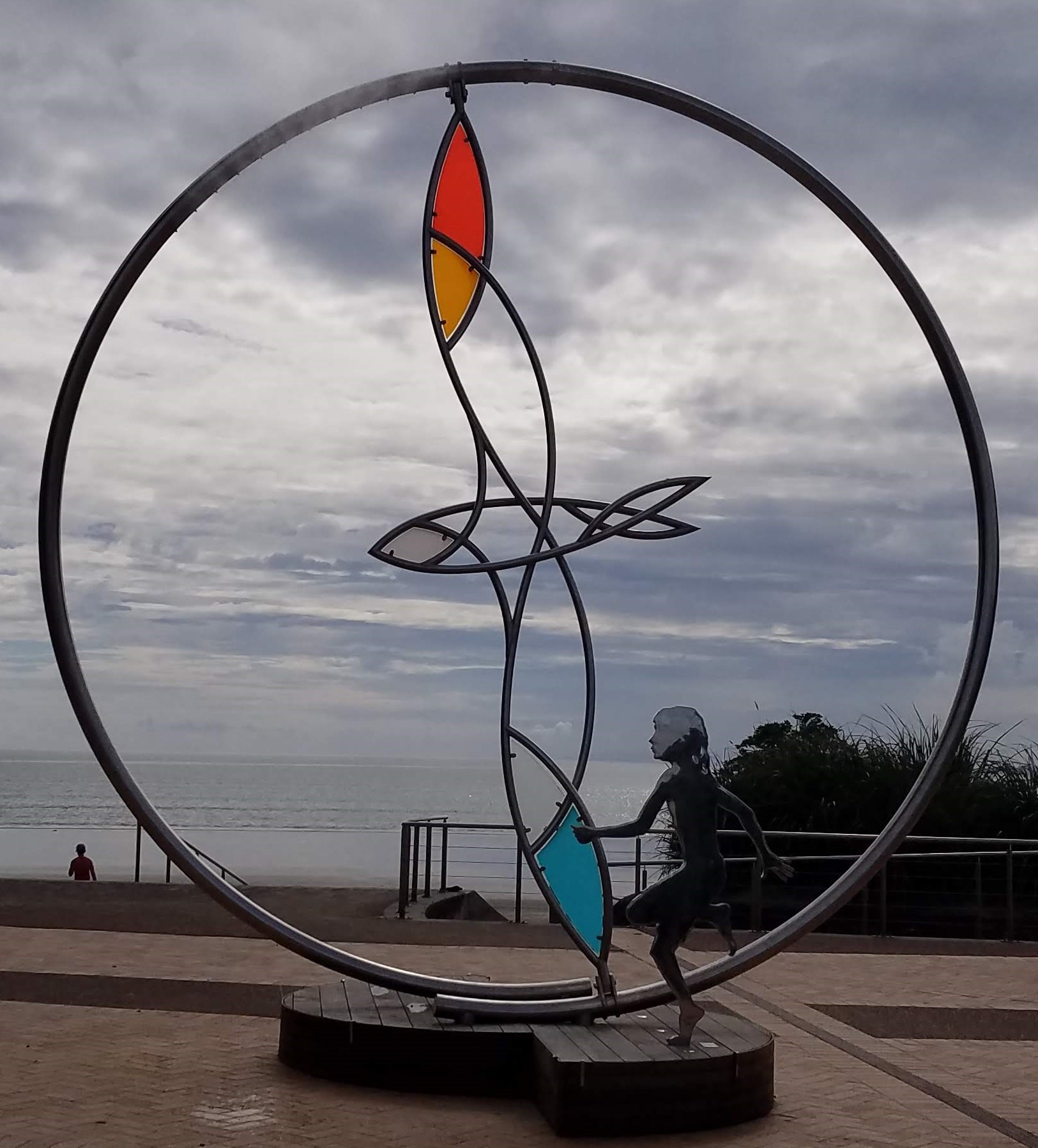
“Airborne,” a sculpture by John Mulholland and Philipp Ripa, sprays mist over visitors to the Moana Reserve
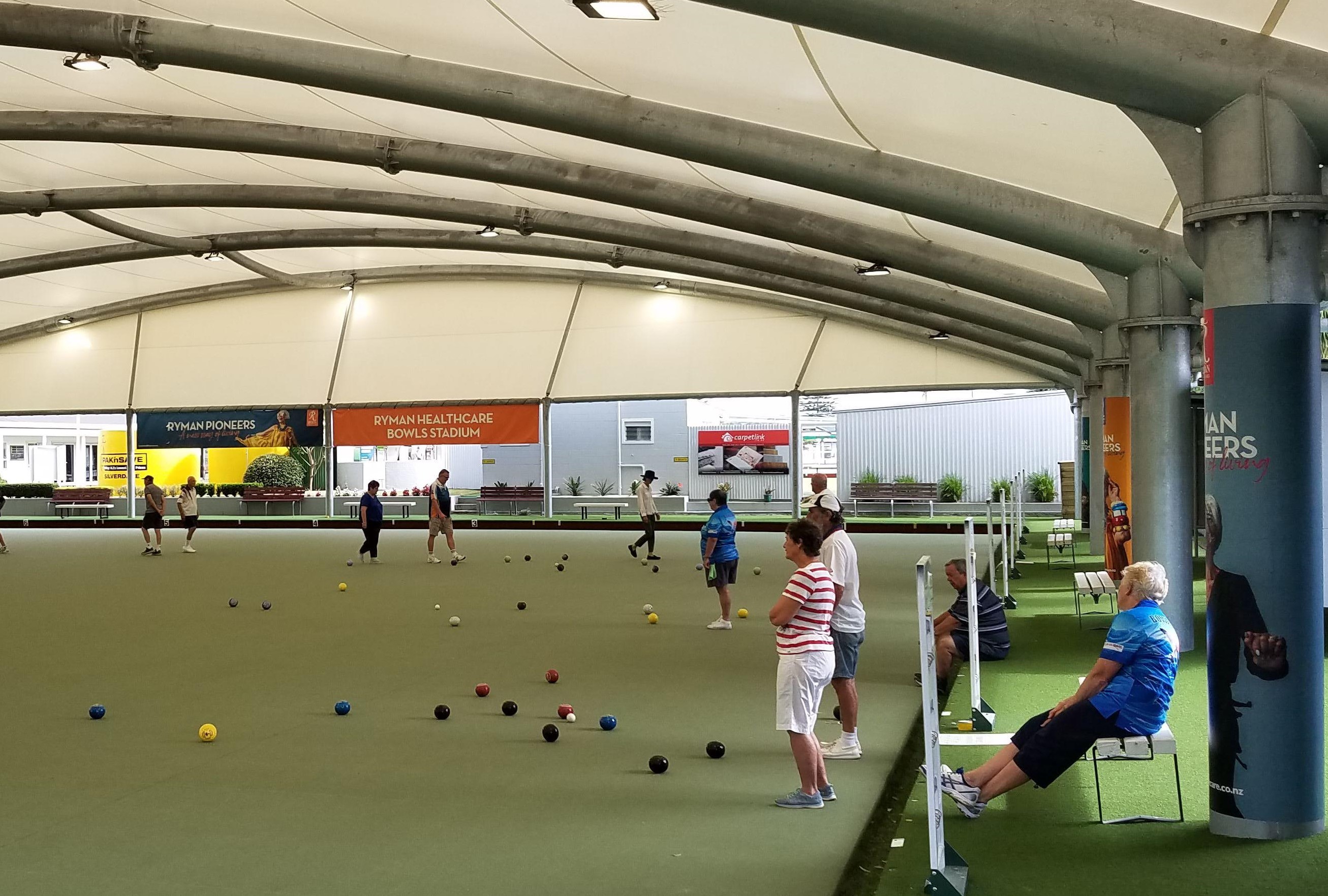
We watched the action at the covered bocce ball court at the Western Reserve Ōrewa for a few minutes
After walking the length of the beach, we scampered across the Hibiscus Coast Highway to buy breakfast at Bake and Brew, and then hurried back across to a picnic table in the Moana Reserve, a greenbelt overlooking the sand and surf. A whole flock of hopeful gulls waited impatiently as we consumed our meal: a meat pie for Nancy and two highly satisfying if less nutritious pastries—a cream bun and a chocolate eclair—for Michael. The gulls had to be content with picking what they could from the paper wrappers we threw in the rubbish bin.
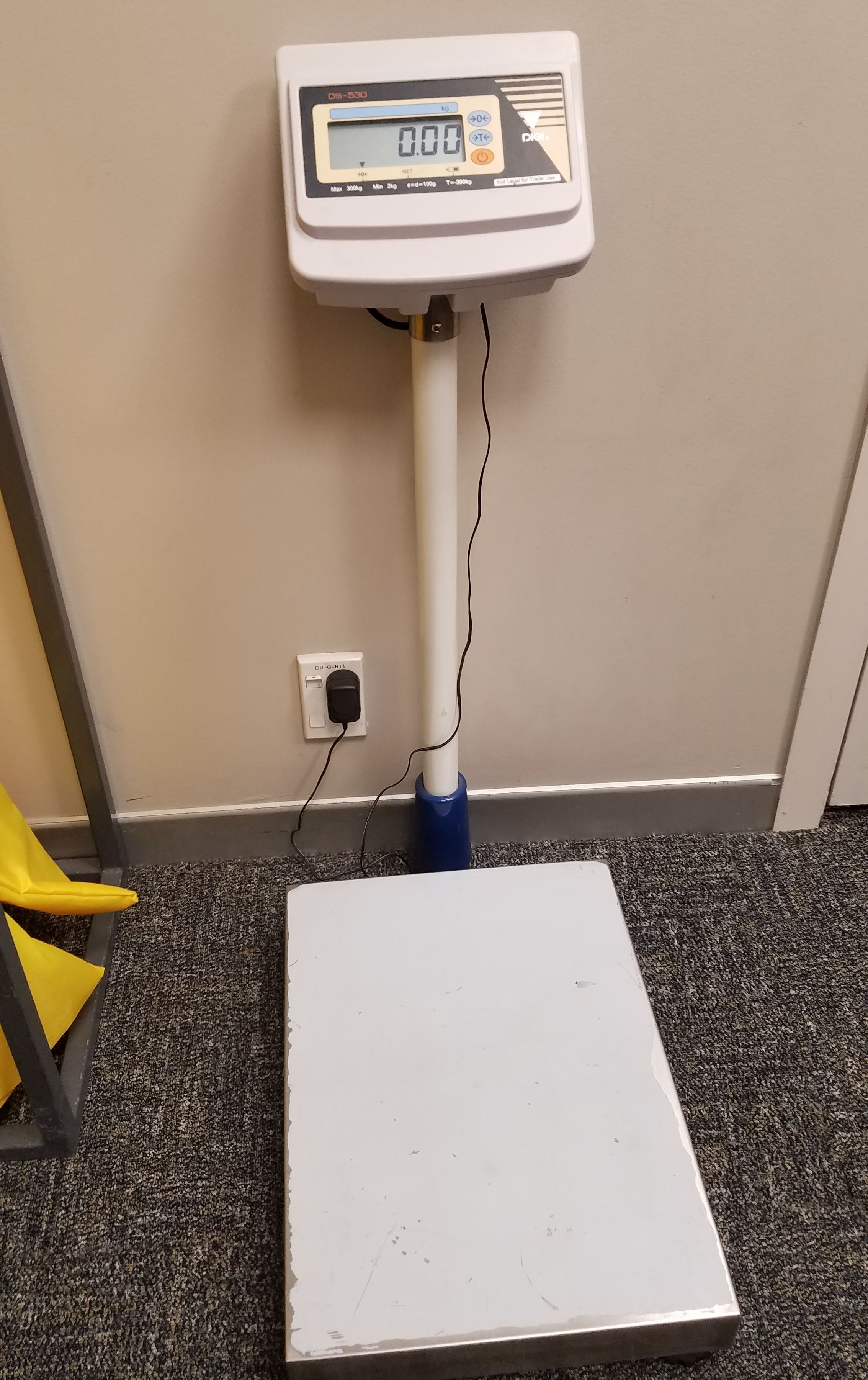
Industrial-size scale in the mailroom of the Church’s Pacific Area office building
Barry and Eva, whose current assignment as executive secretaries to the Church’s Pacific Area presidency has kept them constantly busy, could not afford to take the day off work, so when all of us were done eating we drove back to Takapuna to drop them off at their flat. (Many Aucklanders, Barry and Eva included, were still working from home because the district was still in COVID Alert Level 3.) Collecting the luggage that we had left at Shoalhaven, we then drove to the Church’s Pacific Area office, where the commercial scales in the mail room could tell us exactly how much each of our suitcases weighed. We spent about half an hour shifting items from bag to bag in an effort to ensure that none of them would trigger any overweight fees. Success! Thanks to Michael’s CPAP device, which is exempt from weight restrictions, we managed to include all the chocolate that we hadn’t already eaten or shared with friends, and Nancy was excited to realize that she still had plenty of room for a small stack of Kiwi clothing that otherwise would have gone to the op shop.
Back at Shoalhaven, Michael and Nancy showered and put on the clean, comfortable clothes we would have to wear until we got back to Cincinnati 30-something hours later. The sweaty clothes we had worn to the beach got dumped in the rubbish bin along with our threadbare socks and scruffy sneakers. Jeff and Kara held onto Nancy’s hiking boots because even though they were a little run-down at the heels, they probably would still fetch a few dollars at the op shop.
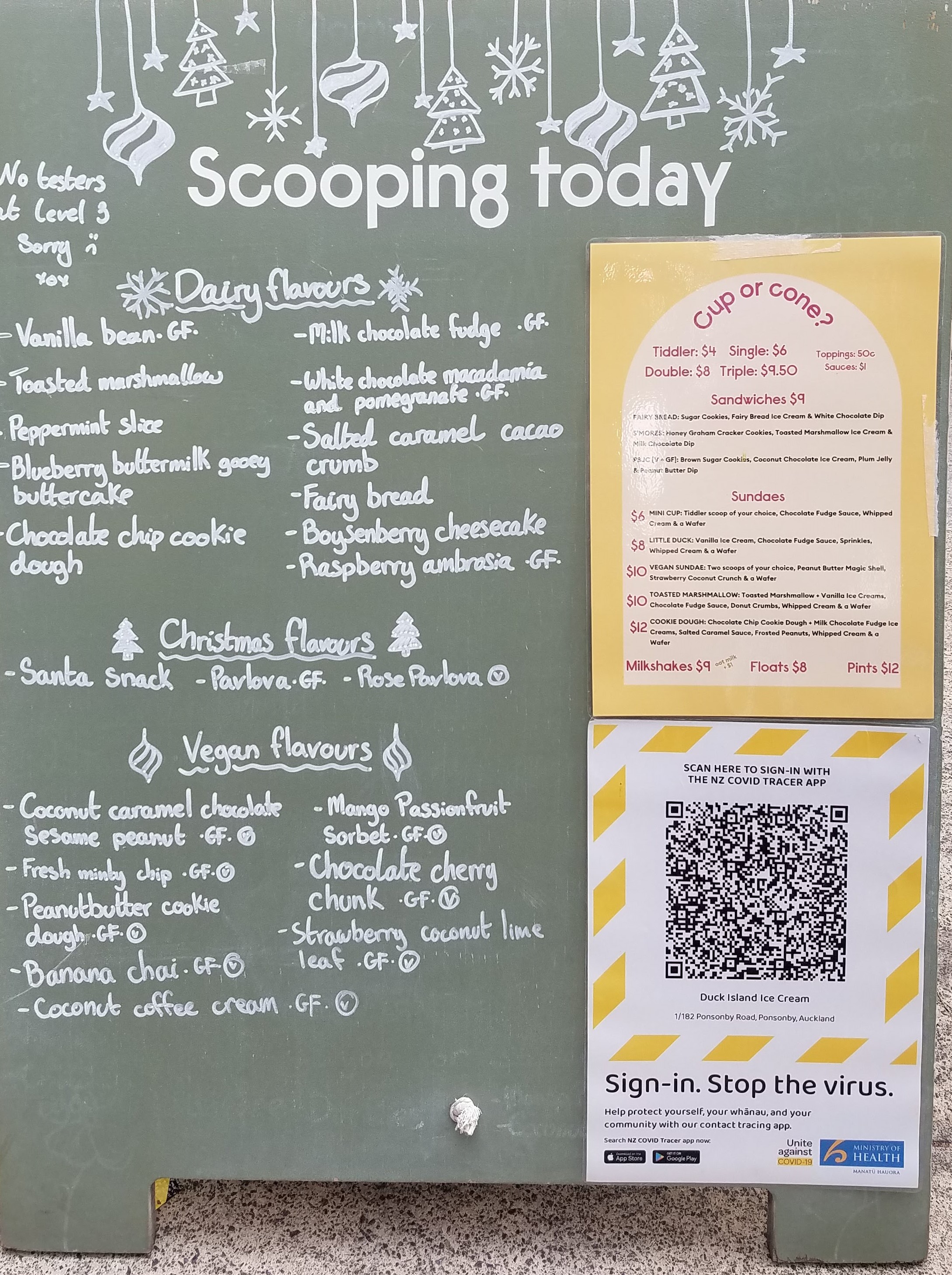
Today’s flavors at Duck Island in Ponsonby
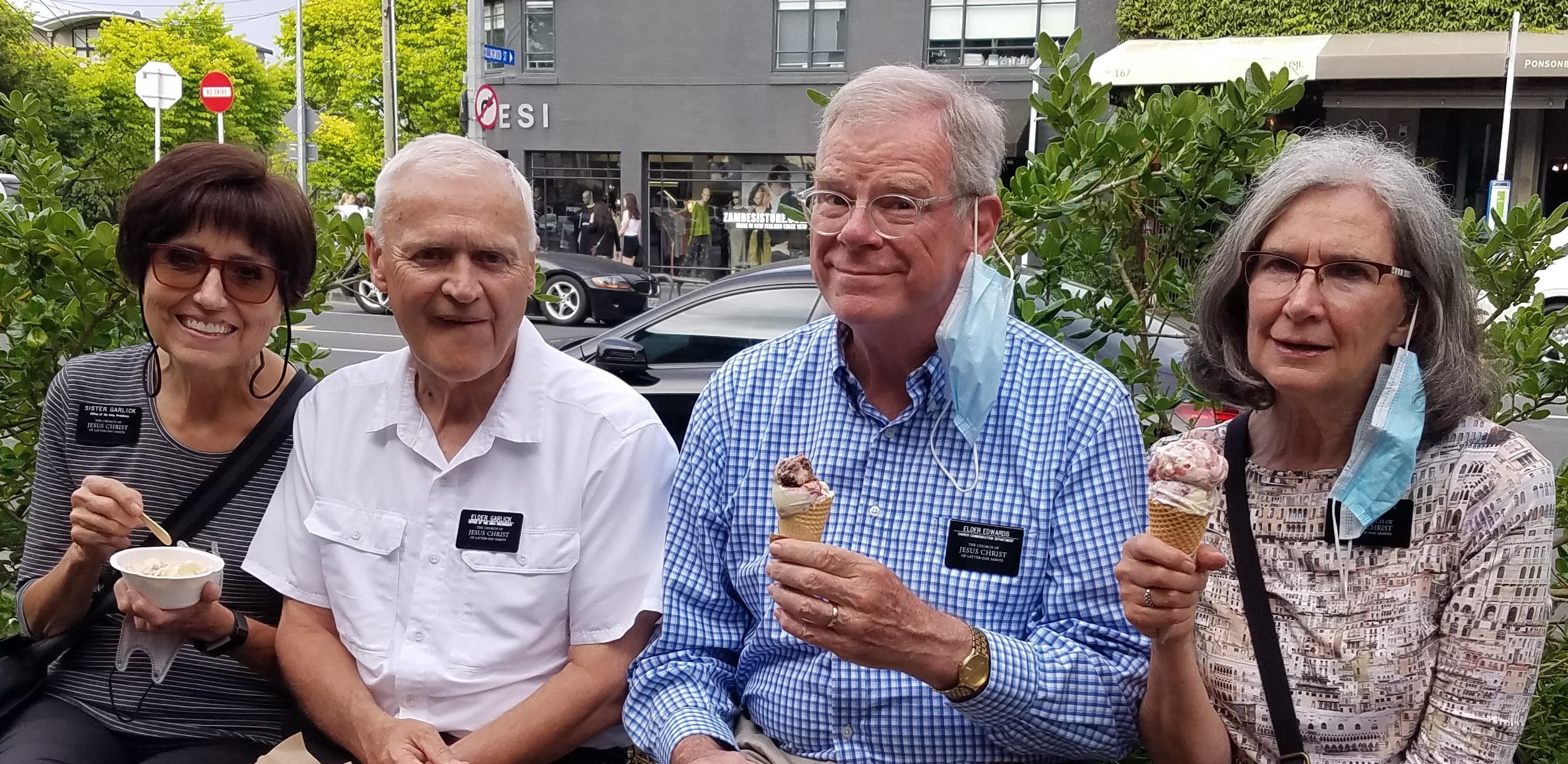
Celebrating with the best ice cream in the world
Around 4:00 p.m. Barry and Eva joined us at Shoalhaven for an early dinner of takeaway pizza and salad. Then we all squeezed into the mission van, where our luggage was already piled up in the back, and headed to Ponsonby for our last scoops of Duck Island ice cream. Everyone was disappointed that this location did not yet have the Brambleberry Goat Cheese flavor Michael had been raving about, but there were plenty of other great, unique combinations to choose from. (Blueberry Buttermilk Gooey Buttercake! Salted Caramel Cacao Crumb! Strawberry Coconut Lime Leaf! Raspberry Ambrosia! Fresh Minty Chip! Coconut Caramel Chocolate Sesame Peanut! Mango Passionfruit Sorbet!)
We arrived at the Auckland Airport about 6:30 p.m. Saying goodbye to our four American friends would have been very difficult had we not known that our chance of seeing them again was much greater than that of seeing the native Kiwi friends we were leaving behind. Barry, Eva, Jeff, and Kara have become like family to us, and the impact they have had on our lives during the past two years is incalculable. We will miss them—but are glad that they will be able to keep us informed about what happens in New Zealand during 2022.
As we placed our bags on the scale at the check-in desk, the agent was very impressed that each registered just under the maximum weight. (“Wow, youse are good! Every one of these is spot-on,” she said.) Breathing sighs of relief, we looked around for a place to sit down. We were so early for our 10:45 p.m. flight that although the check-in desk was open, the security screening area wasn’t, and we were told that it wouldn’t be until 9:00 p.m. We had a long wait ahead of us.
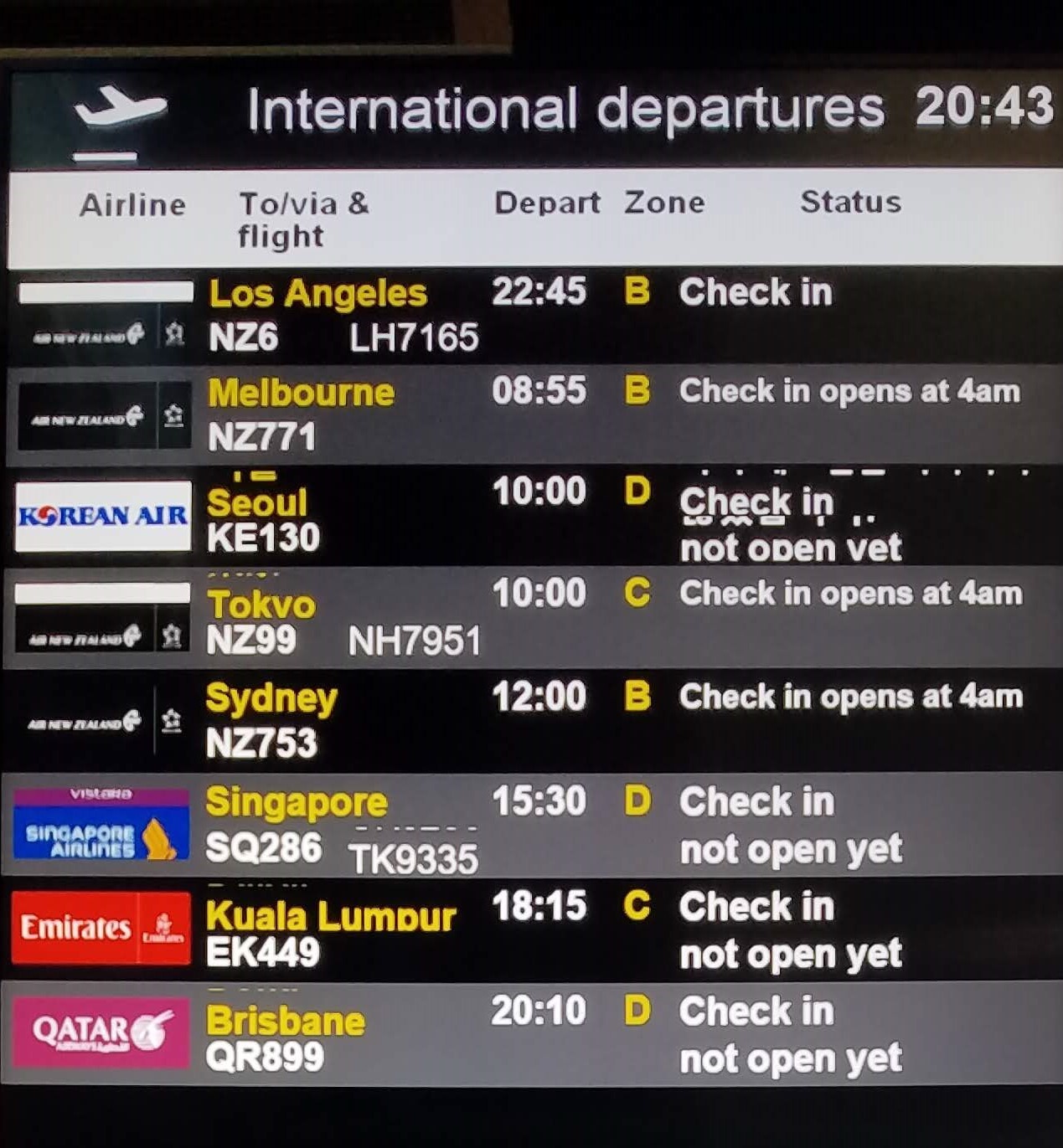
Evidence that New Zealand still has not completely opened its borders
A glance at the departures board told us that only four flights were leaving the international terminal that night, so the whole place was eerily quiet. Nothing was open.
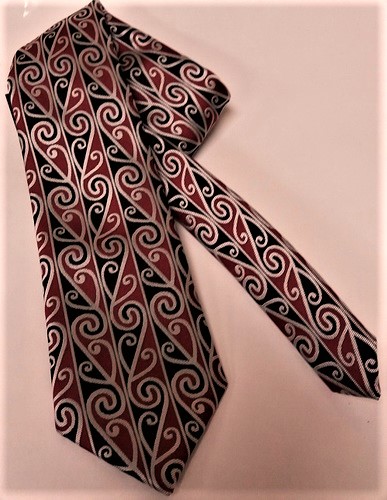
Nancy thought Michael needed a Māori-design necktie like this one, but by early 2021 they were impossible to find in stores
Nancy had hoped that an airport souvenir shop would be the source of last resort for an item she’d been searching for for over a year: a Māori-patterned necktie. Michael didn’t think he needed one, but Nancy thought he did and was determined to buy one for him. She had seen some when we visited Wellington in October 2020 but decided to keep looking; after all, she had plenty of time to find exactly the right one, right? But when she failed to locate a tie with a Māori design in Hamilton in time for Michael’s March birthday, a store manager told her that the factories that once supplied them to souvenir shops around New Zealand had gone out of business; the border closure had deprived them of customers. And now, for the same reason, the spaces at Auckland International Airport where shops had once stood were completely empty. Michael couldn’t even find a place to spend the last of his NZ dollars on a pastry.
So we waited. We walked some—although, with security still closed, we couldn’t go very far. We read some. We wrote some, but it was hard to focus. When the screening station finally opened so we could continue to our gate, we were surprised to find a lot of people already waiting there. There must have been another security line on the other side of the terminal that opened earlier, because we never saw that many people go past us.
We also were surprised that the plane was nearly full. The senior missionaries we knew who had returned to the States within the previous month had reported that their flights were half empty, so passengers had been able to spread out in separate rows and lie down. This was not the case for us. Both of us were glad that Michael had managed to upgrade our seats to “Premium Economy” so we could put them in a slightly more horizontal position, but we still found it difficult to get comfortable. On the other hand, dinner was better than expected. The beef option came with a potato-cauliflower gratin that Nancy pronounced “quite good.” Michael chose the salmon, which was nice and came with couscous and green beans. We got little cups of Kapiti ice cream for dessert.
After dinner, Michael put in his earbuds and started watching movies. The first title that intrigued him as he was scrolling through the options was Juniper, a New Zealand-produced film for which we had seen previews a few months earlier. It was about a troubled teenager who, for therapeutic reasons, is sent to live with a grandmother he hardly knows. Nancy would have liked to watch Juniper, too, but she had taken her contact lenses out and her seatback screen was just the wrong distance away for her eyeglasses to handle. She had intended to start knitting a Christmas stocking for our new grandson while sitting on the plane, anyway, but once the dinner was cleared and the lights were dimmed, it was 1:00 a.m. Auckland time and she was too tired to start a new project. She decided to try to get some sleep.
When Juniper finished (leaving Michael in tears), he started into Dr. Zhivago, a film he hadn’t seen for over forty years. As Nancy struggled to get comfortable enough to fall asleep, she discovered that she could see Michael’s screen better than her own, and Dr. Zhivago turned out to be a perfect companion as she drifted in and out of consciousness. It had probably been about twenty years since she had seen the movie, but she’d watched it so many times in her youth that she could easily run the soundtrack in her head, and if she dozed off for a while and missed a scene or two, so what? Sometime before Yuri and Lara parted for the last time, Nancy finally fell asleep—something she almost never does on a plane—and didn’t wake up until the breakfast service began about five hours later. Michael was not so lucky. He tried several other movies, hoping to find one that would lull him to sleep, but none could sweeten his increasingly sour mood. He did not sleep at all.
It was 1:30 p.m. on Wednesday 1 December when we landed in Los Angeles. Recall that we departed Auckland at 10:45 p.m on Wednesday 1 December, so we now had the opportunity to relive the afternoon and evening of our departure day at a different airport while we waited for our flight to Cincinnati. Michael had hoped to find a somewhat comfortable bench where he could spend those repeated hours in an unconscious state, but that was not to be. Had we been able to hang out in the recently expanded and upgraded Tom Bradley International Terminal at LAX, we probably could have found a quiet place to get horizontal, but after we cleared customs (“Next time, itemize your declared items. Welcome home,” intoned the unsmiling agent), we were directed to Terminal 2 for our connecting flight.
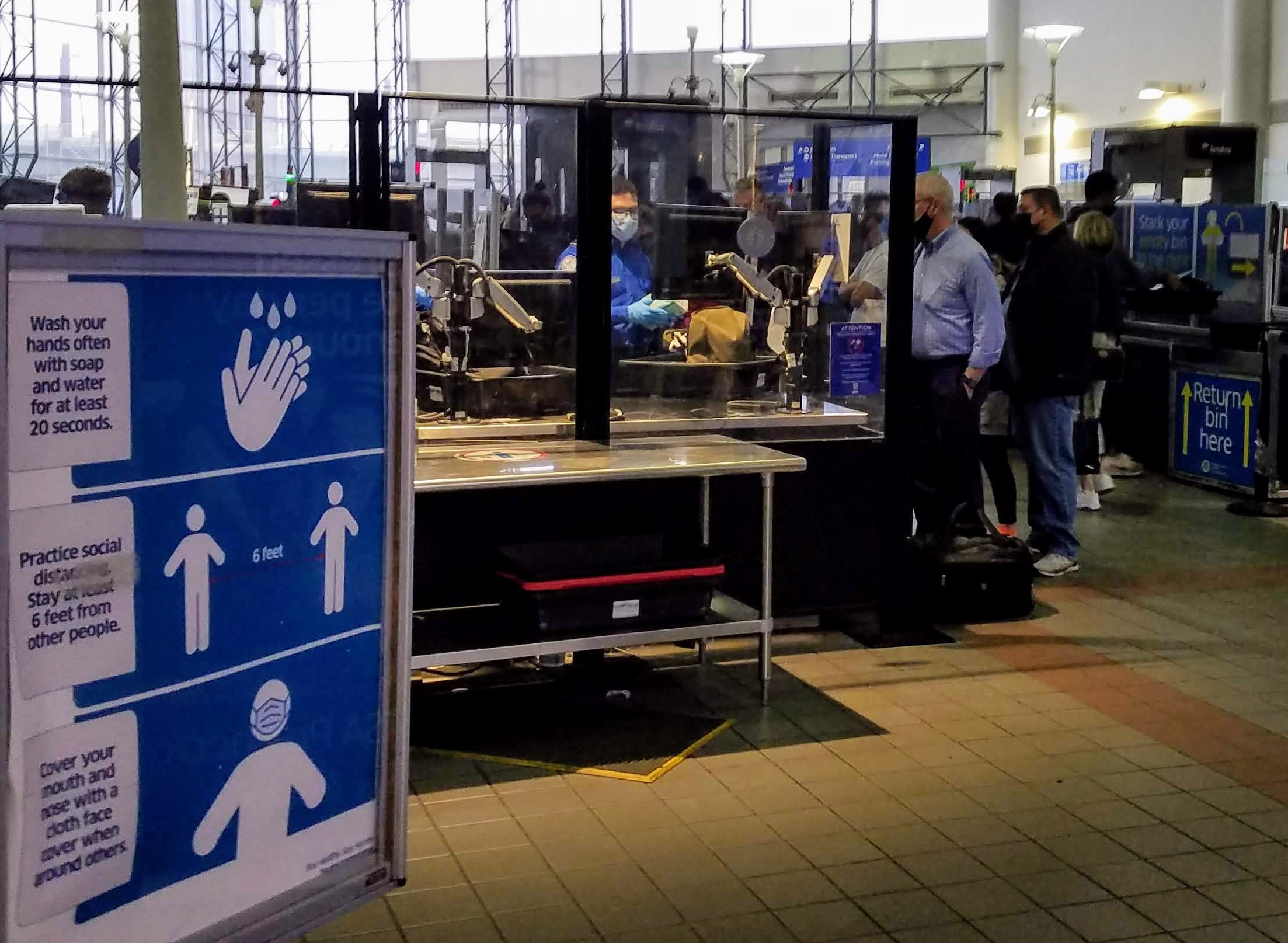
Working our way through TSA at LAX
Because getting from one terminal to the other required going outdoors, we had to submit to a TSA check when we got to Terminal 2. That building was packed with people wearing masks, but although signs everywhere from floor to ceiling reminded us to stay 6 feet away from other people, the maze of ropes and stanchions set up to control the chaos did not allow any such distancing. With COVID’s highly contagious omicron variant now loose in the world, we figured that we’d probably be infected before we left the airport. (Oh well. We wouldn’t really mind spending the next ten days at home in isolation, would we?)
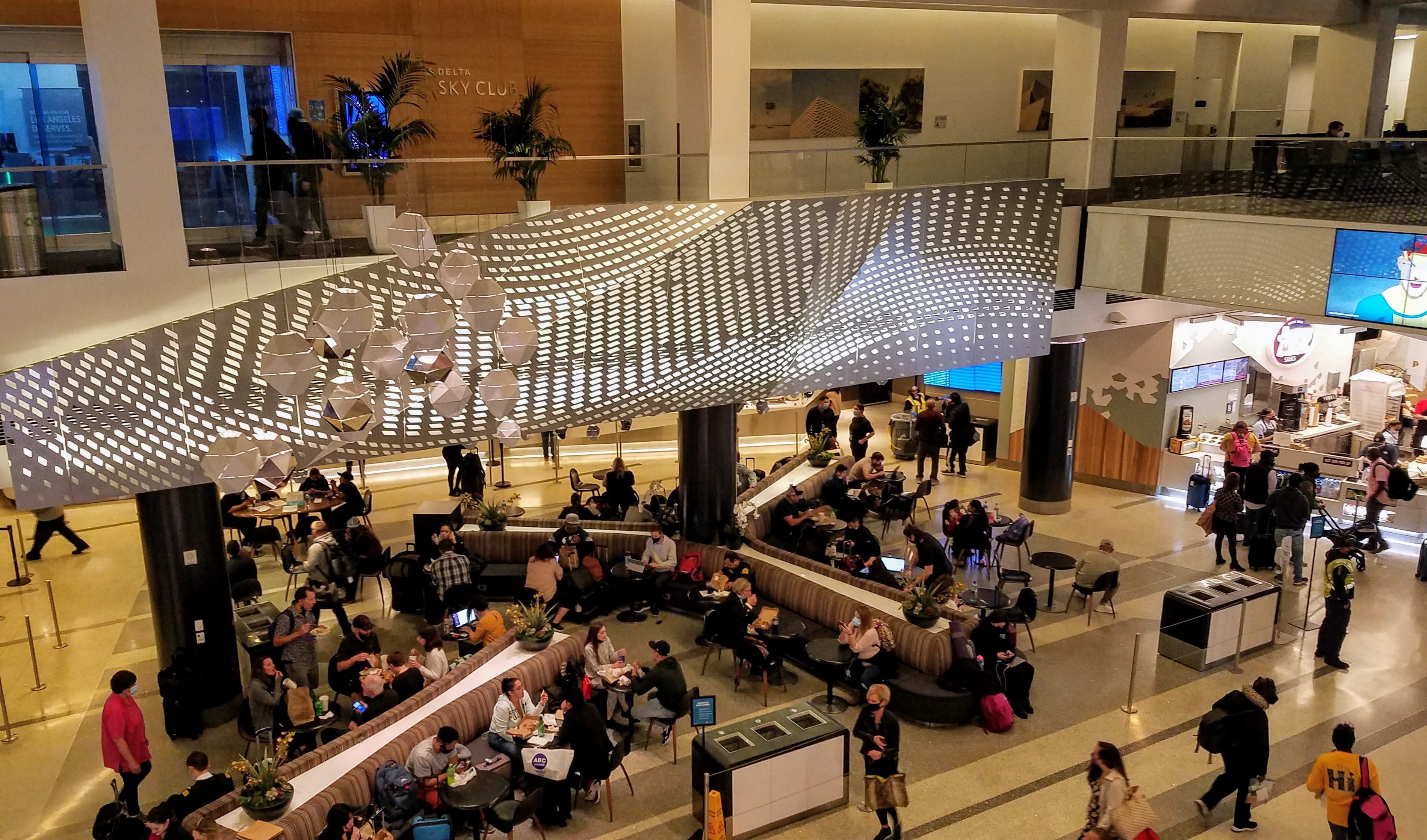
Terminal 2 at LAX was much busier than the international terminal at AKL
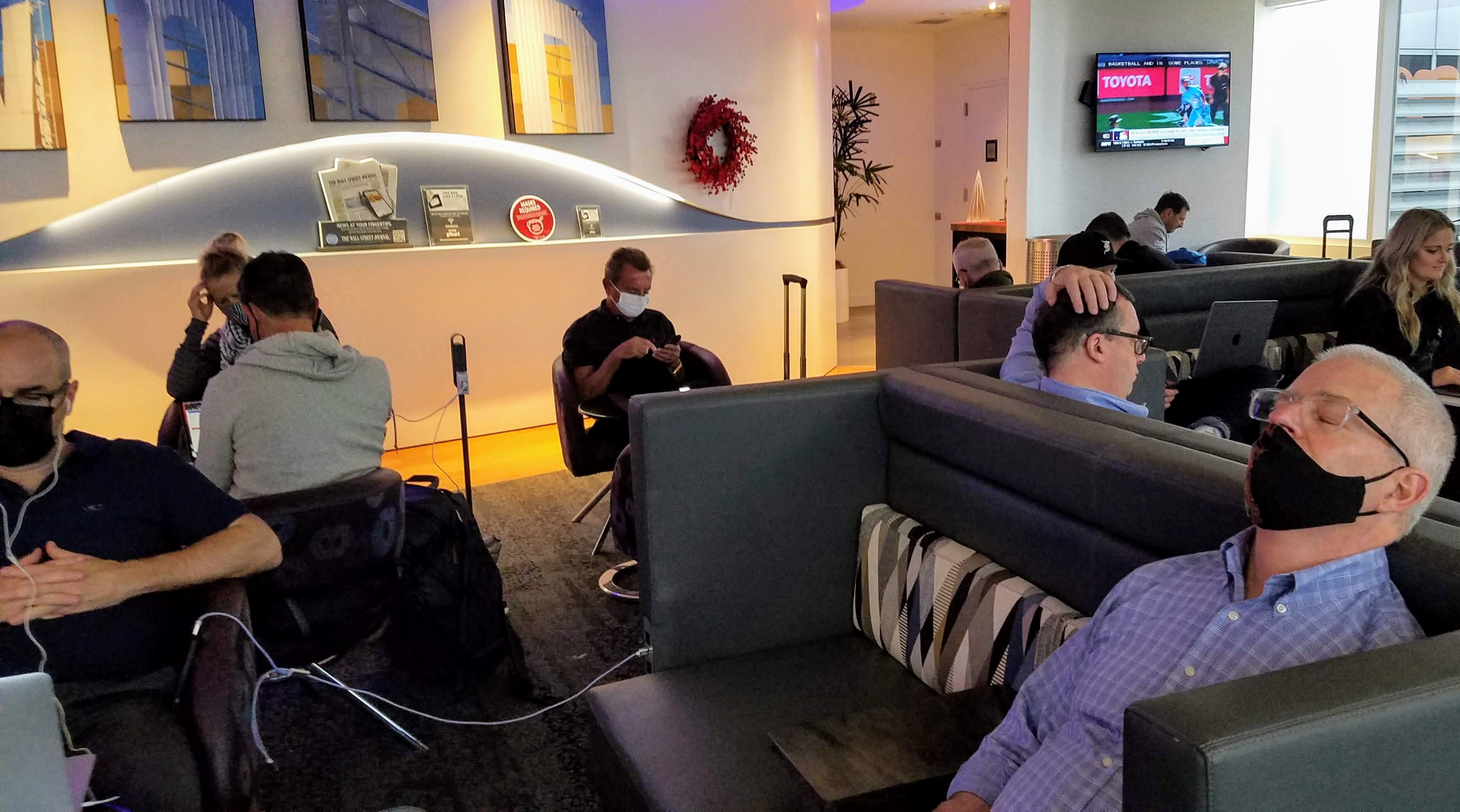
Trying (unsuccessfully) to take a nap in the Delta Sky Club
When we finally got through the security line, we could find no unoccupied seats, let alone a place to lie down. We still had nearly seven hours before we could board our overnight flight to Cincinnati. What to do? Having eaten a hearty breakfast of eggs, bacon, and potato hash on the flight from Auckland only a couple of hours earlier, we weren’t ready for lunch (or dinner, or whatever), but we knew we’d better find something to eat before we left LAX because we’d certainly get hungry before we arrived at CVG, and we knew that no meals would be served on the plane. Unfortunately, Terminal 2 didn’t offer many dining choices: neither Starbucks nor Dunkin Donuts nor Planet Hollywood sounded very appealing. But then Michael noticed the Delta Sky Club. We’re not members, but we do have a Delta SkyMiles platinum card, and we were delighted and relieved to learn that we could gain access to the club by paying for a one-day membership. The entrance fee was about equal to what we would have paid for a meal elsewhere in the airport, and allowed us to graze at the open buffet as much as we wanted. Unfortunately, the club offered nowhere to lie down, but at least it was quiet, so the long layover was not as intolerable as it might have been. Most of the other travelers waiting with us were solitary business-types intent on their screens, but we did have an interesting conversation with a man from London who told us he was a producer for the Angry Birds TV series. That was impressive, but the most intriguing thing about him was that he was clutching a small stuffed elephant. “It belongs to my five-year-old son,” he explained. “He insisted that I take it with me so I wouldn’t get lonely. And—this is hard to admit—I think it has helped!”
Having been in transit for more than 24 hours, we were starting to feel a little numb by the time we boarded our flight to Cincinnati. Delta’s in-flight movie selection seemed less appealing than Air New Zealand’s, so we turned off our seatback screens and shut our eyes, hoping in vain for sleep to come. Four very long hours later, we touched down in Cincinnati. It was 5:15 a.m. on Thursday 2 December, and still dark. CVG’s Concourse B was as deserted as ever (or at least as deserted as it has been since about 2008, when Delta drastically cut the number of its flights moving in and out of the “Queen City”). The familiar emptiness was oddly reassuring, because that’s the way it’s always been whenever we’ve returned home to Cincinnati.
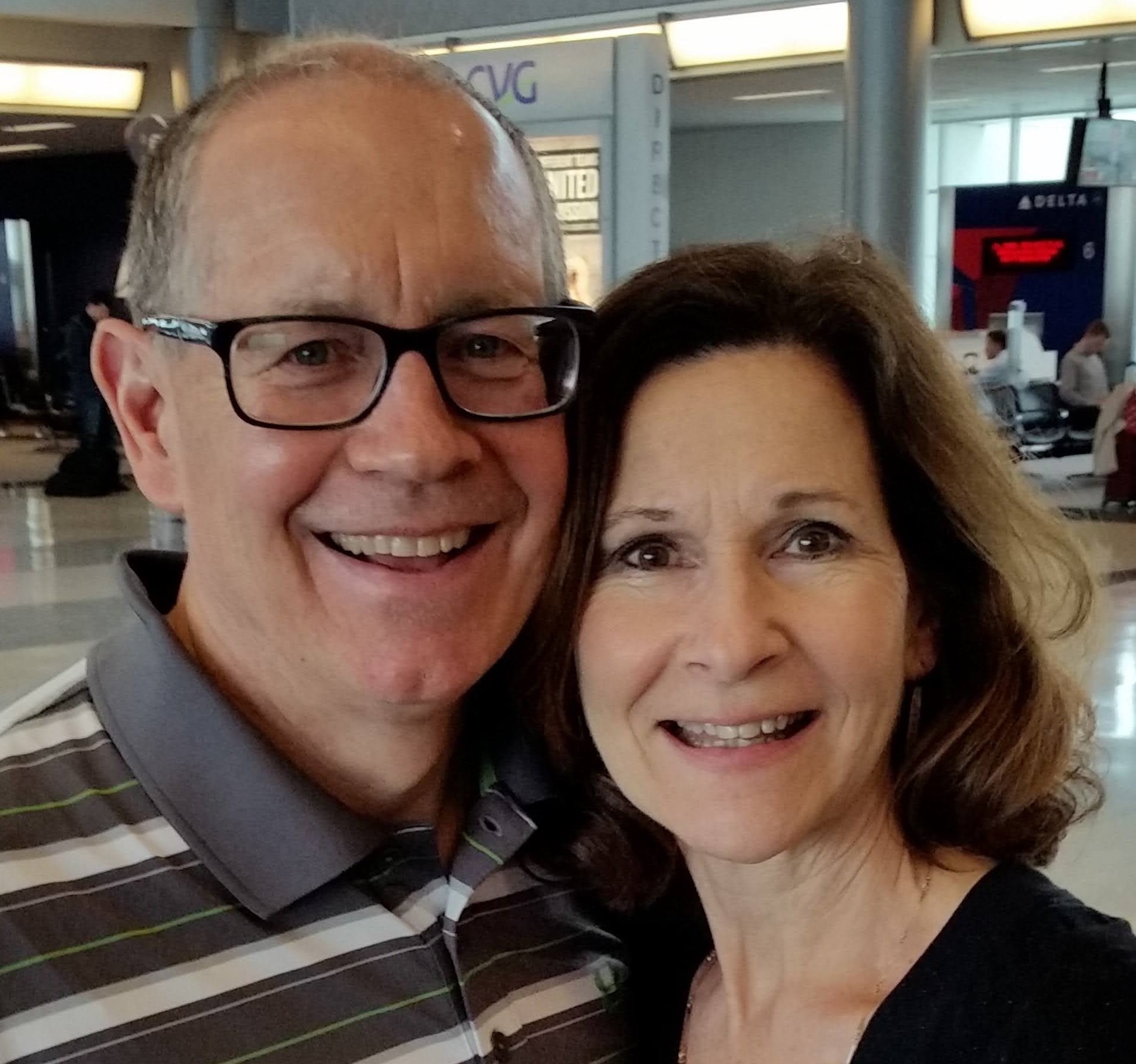
Richard and Judith
Most young Latter-day Saint missionaries coming home after many months abroad are greeted by a horde of excited family members and friends waving “Welcome Home!” banners. We didn’t expect any of our children, grandchildren, or siblings to come to Cincinnati to meet us, and none did—but it was great to see our friends Richard and Judith waving exuberantly as we reached the airport’s meet and greet area. These two had been first among many Montgomery Ward members, neighbors, and friends who had taken care of our house and yard while we were away—a tremendous service that had allowed us to focus on serving the Lord through the Church History Department for the past two years. Julie and Phil had picked up our mail every day; Linda and Allison had kept the pots on our porch planted with annuals; Katie had pruned the roses; Scott and Nathan had mowed the lawn; Ken had cleared snow from the driveway; an army of teenagers had raked and bagged our leaves; Mark had fixed a leaky pipe; and Bethany had come every three months to dust and vacuum. But Judith and Richard were the ones who had accepted full responsibility for our property: doing a walk-through every week, sorting our mail and sending us scans of the important stuff, changing the furnace filter regularly and arranging for the installation of a new furnace when the old one failed, and coordinating the efforts of everyone else involved. No words can express how grateful we are to Richard and Judith, without whom we could not have spent two years in New Zealand. It was wonderful to be able to exchange heartfelt hugs with them back in Cincinnati, and to hear them say, “Welcome home!”
Our time with you in New Zealand is a treasure beyond measure. Thank you for your love and for documenting your experience.
Thanks for sharing this and for the info on how you managed to leave your home. It helps me to see possibilities as we contemplate a mission. Hope all is well with you and yours now that you’ve been home for some months. Call us when you’re next coming to Utah.
Well done thou good and faithful servants! Love you both!
You have forever special memories of a mission well done. You two are special people and a great couple.